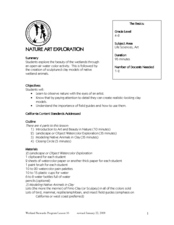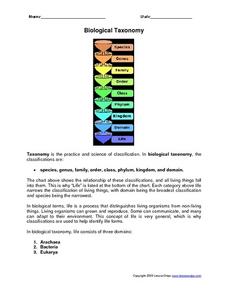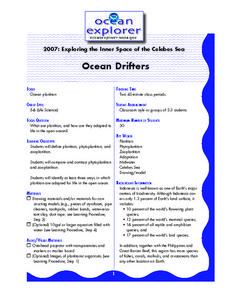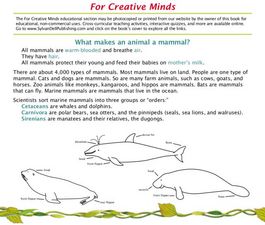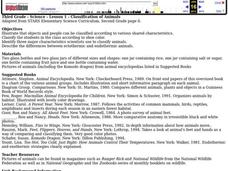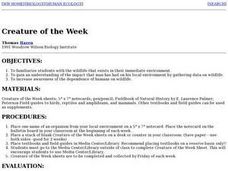Curated OER
Comparing and Contrasting
Young scholars practice compare and contrast skills. In this science and language development lesson, students complete a T chart generating traits of a snail and a clam. Young scholars complete a related worksheet.
Curated OER
Animals
Students explore biology by participating in a science vocabulary activity. In this animal species lesson, students define a list of animal vocabulary terms as well as practice using them in sentences with the appropriate adjectives and...
Curated OER
Nature Art Exploration
Young scholars draw a nature landscape using watercolors. In this life science lesson, students share their personal experience on the beauty of nature. They create clay models of different native animals.
Curated OER
Comparing Two Turtles
Young scholars compare and contrast the various observable features of two different turtles. in groups, they complete a visual analysis of the sea turtle and tortoise. Using their observations, they complete Venn Diagram of the...
Curated OER
Types of Scientists
In this science learning exercise, students match each type of scientist listed in the left-had column to its correct description found in the right-hand column. There are 34 different scientists to match on the sheet.
Curated OER
Biological Taxonomy
For this biology worksheet, students read about biological taxonomy. They then use the information they learned to answer the 13 questions on the worksheet. The answers are on the last page of the packet.
Curated OER
"Sleep"
In this reading comprehension worksheet, students read a passage about sleep cycles. Students answer 11 multiple choice questions about the text.
Curated OER
Great Blobs of Jelly!
Learners explain how zoo-plankton have an impact on the global process. In this ocean zoo-plankton lesson plan students calculate carbon flux and plankton densities.
Curated OER
Ocean Drifters
Students define terms, and identify three ways in which plankton are adapted for life in the open ocean. In this ocean drift lesson students design a planktonic organism.
Curated OER
Do You Have the Key?
Students practice using a dichotomous key. In this classification lesson, students read an article about scientific exploration and identification of new species. They use a dichotomous key to identify objects and create their own key.
Curated OER
Outta Gas
Learners explore practical problems that are related to scuba diving. In this oxygen lesson students complete a lab activity.
Curated OER
Let's Get Specific
Students explore how different species thrive. In this speciation lesson students research and complete a lab activity.
Curated OER
Seeing Green Crossword Puzzle
In this seeing green activity worksheet, students use the 25 clues and word bank to identify the words needed to complete the crossword puzzle.
Curated OER
For Creative Minds: What Makes an Animal a Mammal?
Students read about categories of mammals and their features. Students then construct a marine animal, using given print outs in the lesson. Students then create adaptations for their mammal, using a web site reference for guidance.
Curated OER
Vertebrate Classification Challenge
Students determine which animals belong to the vertebrate phyla. In this classification instructional activity, students are given large papers with the names of the phyla of vertebrates. They must work together to place organisms...
Curated OER
Animals Galore
Third graders use structural characteristics to sort and classify animals into groups.
Curated OER
Animal Classification
Young scholars classify animals. In this animal classification lesson, students identify characteristics from each of the 5 categories of vertebrates. Young scholars group animals by categories.
Curated OER
Collecting Fossils
In this fossils worksheet, students will read about the hobby of fossil collecting and the tools needed for collecting fossils. Students will complete 3 short answer questions based on their reading.
Curated OER
Animals That Begin With...
In this animal names instructional activity, students follow directions to name animals that begin with various letters of the alphabet. A website reference for additional resources is given.
Curated OER
Sorting Pond
Students practice balancing while learning the classifications of different animals
Curated OER
An "Eggs"traordinary Sculpture
Eighth graders identify and categorize different types of animals which lay eggs, use a five step method for viewing and interpreting a piece of artwork, and use an indirect method to find the mass of a large object.
Curated OER
Classification of Animals
Third graders practice classiyfying items and identify three major characteristics scientists use to classify animals. They describe the differences between ectothermic and endothermic animals.
Curated OER
Animal ABC Book
Students in class choose a letter of the alphabet and uses the Enchanted studying web site to pick which animal they copy and paint for their letter. Students copy animal printout and paint or color it.
Curated OER
Creature of the Week
Students explore the habits and biology of the wildlife that resides in their area. They fill in a Creature of the Week sheet for a different animal each week using field guides and textbooks.
Other popular searches
- Reptiles and Amphibians
- Reptiles Amphibians
- Amphibians and Reptiles K 2
- Reptiles & Amphibians
- Amphibians and Reptiles K
- Reptiles Amphibians Fish
- Compare Reptiles Amphibians
- Amphibians and Reptiles Prek
- Reptiles Amphibians Birds
- Amphibians and Reptiles Unit
- Amphibians and Reptiles Perk
- Amphibians and Reptiles 3 5


